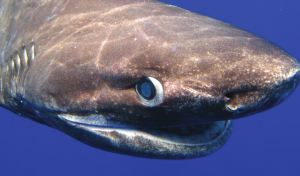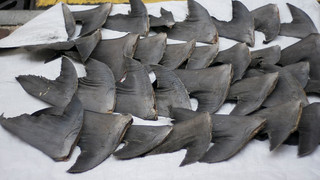Posts
Why We Won’t Quit the Caribbean
/in Cuba, Cuba Research & Conservation, Featured, Ocean Doctor's Reflections, USA & Territories/by Ocean Doctor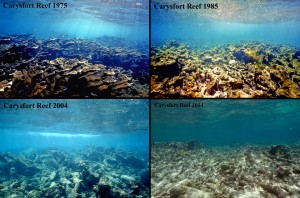
A dramatic time series of photos documenting the 95 percent loss of coral cover from Carysfort Reef, Key Largo, Florida since 1975. The photos capture the loss of a once thriving colony of elkhorn coral, Acropora palmata (Photos: Phil Dustan)
You wouldn’t know it from the colorful travel ads, but beneath the Caribbean’s sublime azure surface, the story of is one of utter mayhem.
A major report released earlier this year, the most comprehensive to date, puts it clearly and bluntly: Without swift and meaningful action, “Caribbean coral reefs and their associated resources will virtually disappear within just a few decades…” There has been an average decline of coral cover in the Caribbean of more than 50 percent since 1970.
The reefs I so delighted in as a teenager in the Florida Keys are today heartbreaking and unrecognizable. Live coral is estimated to be less than 20 percent of what it was in the early seventies when I first dove there.
Statistics like these make it easy for one to abandon hope, and indeed, many have. The report states, “Concerns have mounted to the point that many NGOs [non-governmental organizations, nonprofit conservation organizations and funders] have given up on Caribbean reefs and moved their attentions elsewhere.” But Ocean Doctor hasn’t given up on the Caribbean — we’re in it for the long-haul, dedicated to restoring Caribbean coral reefs to their former glory. And we’ve found a new reason to be optimistic. Read more
The Single Word I Taught First Graders in Cuba
/in 50 States Expedition, Cuba, Featured, Ocean Doctor's Reflections, Travel Program/by Ocean Doctor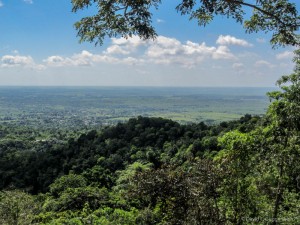 At a rural Cuban elementary school nestled in the verdant mountains west of Havana, I approached the front of the class and queued up my best Spanish. The first-graders looked at me with puzzled anticipation — they don’t see many Americans entering their classroom, let alone U.S. visitors who try to get up and teach. But as soon as it was clear we were going to talk about the oceans, its was all smiles and excited participation, as if salt water is the universal language we all share and treasure.
At a rural Cuban elementary school nestled in the verdant mountains west of Havana, I approached the front of the class and queued up my best Spanish. The first-graders looked at me with puzzled anticipation — they don’t see many Americans entering their classroom, let alone U.S. visitors who try to get up and teach. But as soon as it was clear we were going to talk about the oceans, its was all smiles and excited participation, as if salt water is the universal language we all share and treasure.
I told the students that our lesson was about a single word: Orgulloso. It means “proud.” I told the students that they should “sentirse orgulloso” — feel proud, and then I showed them why. Carrying my laptop around the class, I showed recent videos I had taken in Cuba’s pristine ocean waters of healthy corals, sharks, goliath groupers, tarpon and, to especially loud shrieks of delight, sea turtles.
VIDEO: What Columbus Might Have Seen
/in Cuba, Featured, Ocean Doctor's Reflections, Travel Program/by Ocean Doctor I’ve just returned from Cuba and before my wetsuit has finished drying, I am packing my bags again. Before I return to Cuba, I wanted to take this opportunity to share a short video I shot during my recent trip at Cuba’s spectacular Gardens of the Queen National Park (Jardines de la Reina), the country’s first marine park and the largest fully-protected marine reserve in the Caribbean. It may also be the healthiest marine ecosystem in the Caribbean, our closest glimpse at the pristine reefs and islands Columbus saw and named for Spain’s Queen Isabella 500 years ago.
I’ve just returned from Cuba and before my wetsuit has finished drying, I am packing my bags again. Before I return to Cuba, I wanted to take this opportunity to share a short video I shot during my recent trip at Cuba’s spectacular Gardens of the Queen National Park (Jardines de la Reina), the country’s first marine park and the largest fully-protected marine reserve in the Caribbean. It may also be the healthiest marine ecosystem in the Caribbean, our closest glimpse at the pristine reefs and islands Columbus saw and named for Spain’s Queen Isabella 500 years ago.
I hope you enjoy the video, but it’s much better in person and I hope to be able to show you personally! Learn more and book your trip!
| [youtube EzfeuRiS61Q 560 340] |
ANNOUNCEMENT: Travel with Ocean Doctor to Cuba’s Gardens of the Queen!
/in Cuba, Featured, News & Announcements, Travel Program/by Ocean Doctor |
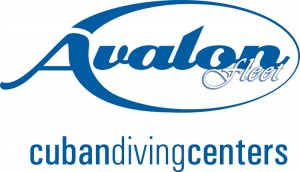 |
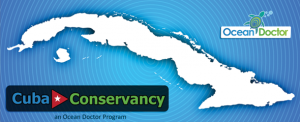 |
|
Legal Educational Travel to Cuba for U.S. Citizens & Residents
For 13 years I have felt deeply privileged to spend much of my time in Cuba, working on research and conservation projects with some of the most incredible people I’ve ever met, among the most spectacularly healthy reefs I have ever beheld. One region in particular, Cuba’s Gardens of the Queen, is so staggeringly pristine and healthy – in stark contrast to many of the other coral reef ecosystems around the world – that the region was recently featured on an award-winning segment of the CBS news program, 60 Minutes, hosted by Anderson Cooper.
 In a world where many of the ocean’s corals and fish populations are in decline, the marine life of Cuba’s Gardens of the Queen – the largest no-take marine reserve in the Caribbean – is thriving. The massive and strikingly beautiful Gardens of the Queen National Park is located 60 miles off the southern coast of Cuba, an archipelago comprising a chain of 250 virgin coral and mangrove islands extending along 75 miles of turquoise waters.
In a world where many of the ocean’s corals and fish populations are in decline, the marine life of Cuba’s Gardens of the Queen – the largest no-take marine reserve in the Caribbean – is thriving. The massive and strikingly beautiful Gardens of the Queen National Park is located 60 miles off the southern coast of Cuba, an archipelago comprising a chain of 250 virgin coral and mangrove islands extending along 75 miles of turquoise waters.
Due to the U.S. economic embargo against Cuba, it has been virtually impossible for Americans to legally visit Cuba and the Gardens of the Queen for more than 50 years.
Too Much Love for the Fish Everyone Hates
/in Featured, Ocean Doctor's Reflections/by Ocean Doctor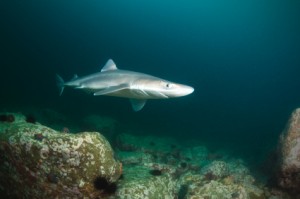
The much-maligned, misunderstood and now treasured “trash fish,” the spiny dogfish (Squalus acanthius). Photo: © Boris Pamikov
It was a sadly typical meeting of the Board of Collier County (Florida) Commissioners in the late nineties. As the meeting droned on, I tuned it out and fell into deep concentration, obsessively rewriting now long-forgotten remarks I would deliver to the Commission about conservation in Southwest Florida on behalf of The Conservancy of Southwest Florida where I was president and CEO. Our environmental policy director, Michael Simonik, suddenly elbowed me, “Can you believe this?” he gasped. As I looked up, Commissioner Barbara Berry was on her soapbox delivering a monologue, and like Michael, I was stunned to hear what she was saying. She soared into hyperbole to sing the praises of the land developers, declaring Southwest Florida far better than when she arrived, and with a look of disgust tinged with horror, told us how awful it was before the developers came, with all of these unsightly “tangles” of trees and messy vegetation. Nature run amok. Thank god the developers came along and made Southwest Florida a better place, with the neatly manicured lawns of its gated communities (not to mention highest number of golf courses per capita in the world). But as I gazed around the room, there were heads nodding. And I learned something. Read more
What Every Good “Shark Week” Fan Should Read While They Watch
/in Featured, Ocean Newswire/by Ocean DoctorVANCOUVER, BRITISH COLUMBIA, CANADA. August 13, 2012 – At the close of the annual meeting of leading American shark and ray scientists, the IUCN Shark Specialist Group (SSG) is releasing the first compilation of conservation status assessments for nearly 300 sharks, rays, and chimaeras (collectively known as chondrichthyan fishes) found in North American, Central American, and Caribbean waters conducted using the IUCN Red List of Threatened Species criteria. The report and supplementary materials can be downloaded from the IUCN website.
The report documents that 13.5% of the region’s shark, skate, and chimaera species qualify for one of the three “threatened” categories — Critically Endangered, Endangered, Vulnerable — associated with an elevated risk of extinction. Nine rays and 20 sharks qualify as Vulnerable. Sixteen percent of species are classified as Near Threatened, 27% as Least Concern, and 43.4% as Data Deficient. Read more
China to Ban Shark Fin Soup at Official Banquets
/in Ocean Newswire/by Ocean DoctorCNN reports that China is planning to ban shark fin soup from official banquets. Shark fin soup is widely served in restaurants in Chinese communities worldwide and traditionally served at weddings.
Read more
Greenland Sharks Are Dog Slow — So How Do They Eat?
/in Ocean Newswire/by Ocean Doctor
Greenland shark part of a drawing in ‘Male Narwhal or Unicorn. Greenland Shark.” In: “An account of the Arctic regions with a history and description of the northern whale-fishery”, by W. Scoresby. 1820. Source http://www.photolib.noaa.gov/library/libr04
We’ve barely explored the world’s oceans, but when it comes to marine life living in the harsh conditions at the poles where few scientists and explorers can spend time, we are constantly being surprised by what we’re discovering. The Greenland shark — the largest shark in the dogfish family — is no exception. It’s slow — really slow — so scientists asked the logical question: “If it’s so slow, how does it catch prey?” The BBC reports on a recent study. Read more
VIDEO: Ocean Checkup – Ocean Doctor on Dr. Kiki’s Science Hour
/in Cuba, Cuba Research & Conservation, Featured, Sustainable Aquaculture/by Ocean DoctorDr. Kirsten “Kiki” Sanford is joined by The Ocean Doctor, David E. Guggenheim on Dr. Kiki’s Science Hour for a checkup on the oceans’ health.
This show originally aired on the TWiT Netcast Network on December 23, 2011. Visit the show page at TWiT.tv.
[iframe src=”http://twit.tv/embed/10389″ width=”580″ height=”290″ scrolling=”no” marginwidth=”0″ marginheight=”0″ hspace=”0″ align=”middle” frameborder=”0″]
Fax: +1 (202) 888-3329
P.O. Box 53090
Washington, DC 20009
Just Released: The Remarkable Reefs of Cuba: Stories of Hope from the Ocean Doctor by Dr. David E. Guggenheim, President of Ocean Doctor

